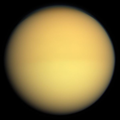tóng-àn:Two Halves of Titan.png
Two_Halves_of_Titan.png (600 × 600 siōng-sò͘ , tóng-àn chiàm-liōng: 108 KB, MIME luī-hêng: image/png)
Tóng-àn le̍k-sú
Chhi̍h ji̍t-kî/sî-kan, khoàⁿ hit sî-chūn--ê tóng-àn.
| Ji̍t-kî/Sî-kan | 細張圖 | 寸尺 | Iōng-chiá | Chù-kái | |
|---|---|---|---|---|---|
| hiān-chāi | 2015-nî 7-goe̍h 14-ji̍t (pài-jī) 12:34 |  | 600 × 600(108 KB) | JorisvS | rv: only black is cropped away |
| 2015-nî 7-goe̍h 14-ji̍t (pài-jī) 11:08 |  | 796 × 798(290 KB) | Crisco 1492 | Reverted to version as of 05:14, 30 December 2010; too tight crop damages composition | |
| 2011-nî 1-goe̍h 9-ji̍t (lé-pài) 02:19 |  | 600 × 600(108 KB) | Antonsusi | Crop canvas of no interest | |
| 2010-nî 12-goe̍h 30-ji̍t (pài-sì) 05:14 |  | 796 × 798(290 KB) | Materialscientist | crop whitespace | |
| 2009-nî 10-goe̍h 16-ji̍t (pài-gō·) 15:15 |  | 1,024 × 1,024(298 KB) | Originalwana | {{Information |Description={{en|1=Seasonal changes in the atmosphere of Saturn's largest moon are captured in this natural colour image which shows Titan with a slightly darker top half and a slightly lighter bottom half. Titan's a |
Iáⁿ-siōng liân-kiat
Í-hā ê ia̍h liân kàu chit ê iáⁿ-siōng:
tóng-àn hō͘ lâng sái--ê chōng-hóng
Ē-kha--ê kî-thaⁿ wiki ēng tio̍h chit--ê tóng-àn:
- af.wikipedia.org hō͘ lâng ēng--ê chêng-hêng
- ar.wikipedia.org hō͘ lâng ēng--ê chêng-hêng
- ast.wikipedia.org hō͘ lâng ēng--ê chêng-hêng
- as.wikipedia.org hō͘ lâng ēng--ê chêng-hêng
- be.wikipedia.org hō͘ lâng ēng--ê chêng-hêng
- bg.wikipedia.org hō͘ lâng ēng--ê chêng-hêng
- bh.wikipedia.org hō͘ lâng ēng--ê chêng-hêng
- bs.wikipedia.org hō͘ lâng ēng--ê chêng-hêng
- ca.wikipedia.org hō͘ lâng ēng--ê chêng-hêng
- cdo.wikipedia.org hō͘ lâng ēng--ê chêng-hêng
- ckb.wikipedia.org hō͘ lâng ēng--ê chêng-hêng
- cs.wikipedia.org hō͘ lâng ēng--ê chêng-hêng
- de.wikipedia.org hō͘ lâng ēng--ê chêng-hêng
- dsb.wikipedia.org hō͘ lâng ēng--ê chêng-hêng
- eml.wikipedia.org hō͘ lâng ēng--ê chêng-hêng
- en.wikipedia.org hō͘ lâng ēng--ê chêng-hêng
檢視此檔案的更多全域使用狀況。


